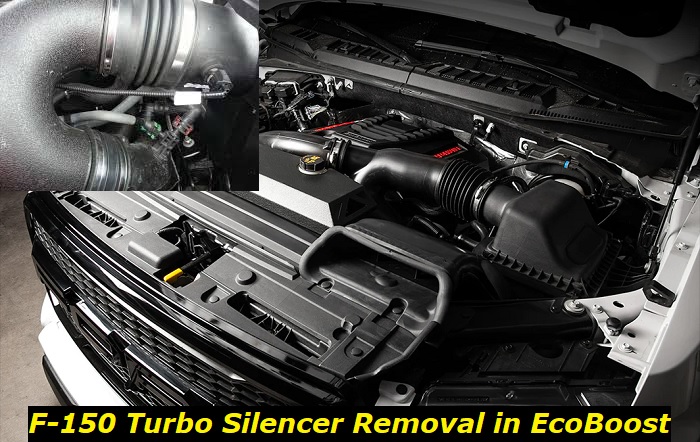There is a lot of talk about turbo silencer removal in the F150 EcoBoost. Each person who had done so or is against the process has a differing opinion of what its real benefit is. Some are positive while others have negative things to say about it.
Engine exhaust problems highlights
- Level of urgency:Medium
- DIY inspection:Possible but complicated
- DIY repair:Impossible
- Cost of repair:$350 - $1,500
- Can you drive?Usually, yes
- Commonreasons:EGR issues, catalytic converter problems, O2 sensor issues, exhaust pipe problems
- Ways to fix:Locating and replacing the part that is malfunctioning

What the Turbo Silencer in the F150 Does
The turbo silencer is a device that muffles the noise generated by the turbocharger in your F150 pickup. It does this by redirecting exhaust gases away from the turbine blades, which reduces the amount of noise that is produced. Additionally, the turbo silencer also helps to improve the efficiency of the turbocharger by preventing exhaust gases from recirculating back into the engine. This results in more efficient engine operation and increased fuel economy.
The turbo silencer is an important part of the turbocharger system and helps to keep your F150 running smoothly and efficiently. Thanks to the turbo silencer, you can enjoy a quieter ride and improved fuel economy due to more efficient airflow.
How to Delete the Turbo Silencer from the F150 EcoBoost
The turbo silencer is beneficial for those who appreciate quiet trips, but those who want to enjoy the brute noise of their turbochargers can opt to have it removed. There are different ways to delete the turbo silencer from your F150 EcoBoost. In this section, we will explore some of the most popular methods employed by motorheads.
- Method 1: Delete the Turbo Silencer with a Welder
The first way to delete the turbo silencer is to weld it shut. This is the most common way to do it and is relatively easy to do. All you need is a welder and some basic welding skills.
To weld the turbo silencer shut, start by disconnecting the exhaust manifold from the turbocharger. Once it is disconnected, you can then weld the wastegate flap to shut off its function. Be sure to use a good quality welder and make sure that the welds are properly done so that they will hold up under pressure.
Once the wastegate is welded shut, reattach the exhaust manifold to the turbocharger and you're done. This is a relatively simple way to delete the turbo silencer and is probably the easiest way to do it.
- Method 2: Delete the Turbo Silencer with a Sawzall
Another way to delete the turbo silencer is by using a sawzall. This method is a bit more difficult than welding it shut, but can be done if you have some basic sawing skills.
To delete the turbo silencer with a sawzall, start by disconnecting the exhaust manifold from the turbocharger. Once it is disconnected, you can then cut off the end of the turbo silencer using a sawzall. Be careful not to cut into any of the other components of the exhaust system while doing this.
Once the turbo silencer is cut off, reattach the exhaust manifold to the turbocharger and you're done. This is a more difficult way to delete the turbo silencer, but it can be done if you are careful and have some basic sawing skills.
- Method 3: Delete the Turbo Silencer with an Exhaust Cutter
The third way to delete the turbo silencer is by using an exhaust cutter. This method is also more difficult than welding or sawing it shut, but can be done if you have some experience with using an exhaust cutter.
To delete the turbo silencer with an exhaust cutter, start by disconnecting the exhaust manifold from the turbocharger. Once it is disconnected, you can then cut off the end of the turbo silencer using an exhaust cutter. Be careful not to cut into any of the other components of the exhaust system while doing this.
Once the turbo silencer is cut off, put back the exhaust manifold to the turbocharger and you're done. This is a more difficult way to delete the turbo silencer, but it can be done if you have some experience with using an exhaust cutter.
- Which Method Suits You?
Deleting the turbo silencer from your F150 EcoBoost is a relatively simple process that can be done in a number of different ways. In this section, we have explored three of the most popular methods. Choose the method that you feel most comfortable with and get to work. Your F150 will thank you for it.
Things to Remember Before Deleting Your F150 Turbo Silencer
Some extra research and a careful thought will take some extra time and effort, but it might well be worth it if you want to extract the best experience out of your engine while avoiding any potential complications along the way. So, before undertaking this neat hack, be sure to weigh the potential repercussions of your actions via the following factors:
1. Be Careful Not to Run in Trouble with the Law
Prior to the removal of the turbo silencer from your F150, you'll want to ensure that it is compliant with state laws. Depending on where you live, these regulations will differ, but California in particular is known for its tough standards via The State of California's Air Resources Board (CARB).
Auto alterations are a hot topic with many different regulations. You need to make sure you're up-to-speed on the laws in your location before you start making changes to your vehicle. Some places have very specific rules about which parts of the truck can be modified, and there may also be extra steps like getting official paperwork and inspections done before you are allowed to do so.
Next, investigate the maximum noise levels and air pollution restrictions for the area where you will be driving your vehicle. After making modifications to your auto, make sure that it does not exceed these limits. emission changes should also fall within permissible levels. When researching general standards, look into regulatory bodies such as the Environmental Protection Agency (EPA) and its subsidiary, Department of Motor Vehicles (DMV).
Lastly, the improvements should follow the safety protocols set by the National Highway Traffic Safety Administration (NHTSA) and other state regulatory organizations.
2. Be Considerate of Your Community
This is definitely a neat trick if you want to enjoy the raw turbo sound of your auto. However, there's a big chance that not all will be so happy about your decision. It would be a good idea to take this into consideration before you make any changes.
If you live in an urban area, blaring engine noise might not be the best idea as it can often disturb others, especially during nighttime hours. It would be best to avoid doing this or at least use a little bit of caution and common sense when you do.
Rural areas are a bit more lenient when it comes to engine noise, but that doesn't mean you should just go all out and be as loud as possible. There's a difference between being considerate and being an annoyance, so use your best judgment.
3. Check If Your Warranty Will Be Affected
In some cases, making changes to your pickup can void the warranty that came with it. Before you do anything, check the terms of your warranty to see if there are any stipulations about modifications.
If your warranty is still valid, find out if there are any conditions that would void it such as using aftermarket parts or changing the way the vehicle operates. If you're not sure, it's always best to err on the side of caution and consult with a professional before making any drastic changes.
4. Determine If You Need Special Tools or Parts
Depending on which method you choose, you might need to get your hands on some special tools or parts before deleting your F150 turbo silencer. Do some research to find out exactly what you'll need and make sure you have everything on hand before getting started.
5. Expect Extra Engine Noise
Once the silencer is removed, your engine will be a lot louder than it was before. This is something to keep in mind if you're not a fan of loud noises. If you want to avoid drawing too much attention to yourself, it might be best to save this mod for when you're driving on highways or other open roadways.
6. Be Careful Not to Damage Other Parts of the Engine
When you're working around the turbocharger, it's important to be careful not to damage any other parts of the engine. This area is full of delicate components, so it's best to take your time and avoid rushing things.
7. Make Sure You Know What You're Doing
Removing the turbo silencer on your F150 is a pretty straightforward process, but it's always best to know what you're doing before getting started. If you're not confident in your abilities, it might be a good idea to consult with a professional or someone who has experience with this type of work.
8. Be Prepared for Some Extra Expenses
Depending on which method you choose, deleting your F150 turbo silencer can end up being a fairly costly endeavor, especially on the resulting maintenance costs. If you're not prepared to spend a bit of money, it might be best to hold off on this mod for now.
Conclusion
After carefully considering all of the factors, it's time to make a decision about whether or not you want to delete the turbo silencer on your F150. If you're feeling confident and you're prepared for the potential consequences, go ahead and give it a try.
Otherwise, it might be best to leave things as they are. Remember, there's no shame in admitting that this particular mod isn't for you. Not everyone is cut out for it, and that's perfectly okay.
About the authors
The CarAraC research team is composed of seasoned auto mechanics and automotive industry professionals, including individuals with advanced degrees and certifications in their field. Our team members boast prestigious credentials, reflecting their extensive knowledge and skills. These qualifications include: IMI: Institute of the Motor Industry, ASE-Certified Master Automobile Technicians; Coventry University, Graduate of MA in Automotive Journalism; Politecnico di Torino, Italy, MS Automotive Engineering; Ss. Cyril and Methodius University in Skopje, Mechanical University in Skopje; TOC Automotive College; DHA Suffa University, Department of Mechanical Engineering






Add comment